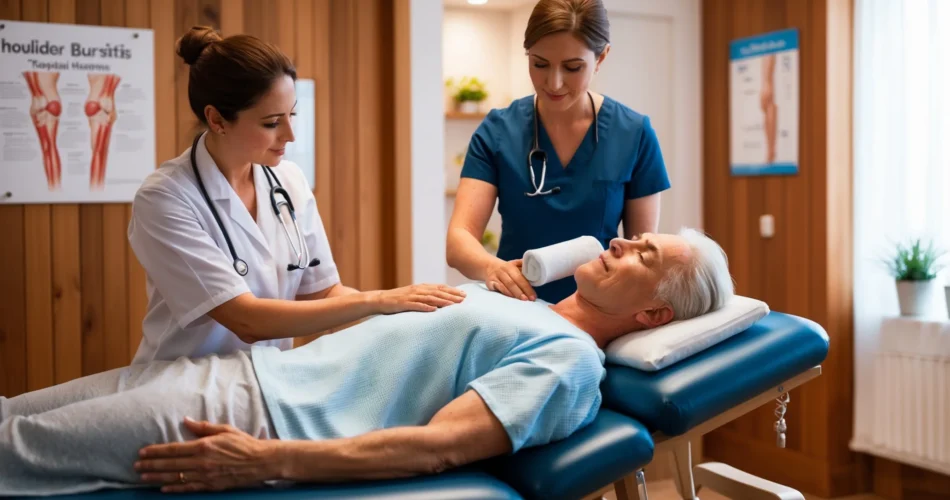Bursitis, also called shoulder bursitis, occurs when the tissue around your shoulder joints becomes inflamed and causes irritation. This condition can be caused by overuse, injury, or infection and often develops slowly over time.
To understand the best physical therapy for shoulder bursitis, you need to understand how physical therapy works for this condition and why it’s an effective option to manage your pain and prevent further deterioration of your joint.
What is shoulder bursitis?
Shoulder bursitis is an inflammation of the bursa, a small fluid-filled sac that acts as a cushion between the tendons and bones in the shoulder. The most common shoulder bursitis symptom is shoulder pain, ranging from mild to severe. Other symptoms may include swelling, Redness, and warmth in the affected area.
If you think you may have shoulder bursitis, you must see a doctor or physical therapist for an accurate diagnosis. They may order a lab test or chughtai test report to confirm the diagnosis. Treatment for shoulder bursitis typically includes rest, ice, and physical therapy exercises. Surgery may be necessary to remove the inflamed bursa in some cases.
How do you get shoulder bursitis?
Shoulder bursitis is an inflammation of the bursa, a small, fluid-filled sac that acts as a cushion between bones and tendons. The most common cause of shoulder bursitis is repetitive overhead motions of the arm, such as those often used in sports. Other causes include direct trauma to the shoulder, infection, and arthritis.
Symptoms of shoulder bursitis include Pain and Tenderness in the shoulder, particularly when moving the arm overhead. The Pain may also radiate down the arm. Diagnosis is typically made based on a physical examination and medical history. Chughtai lab Lahore can do special tests to confirm the diagnosis. Treatment of shoulder bursitis includes rest, ice, and physical therapy. Surgery is rarely needed.
The physical therapy treatment plan:
- Chughtai lab Lahore offers a wide range of tests to help diagnose shoulder bursitis.
- A physical therapist will develop a treatment plan based on the results of these tests.
- Physical therapy aims to reduce Pain and inflammation in the shoulder joint.
- Physical therapy may include exercises, massage, and ice or heat therapy.
- Your physical therapist will likely give you a home exercise program to continue your progress after you leave the clinic.
- Chughtai lab report is essential to track your progress and see how well the physical therapy works.
Recovery timeline
Most people with shoulder bursitis recover within a few weeks with the help of physical therapy. However, the chughtai test report found that some people may take up to three months to recover.
The best physical therapy for shoulder bursitis includes exercises that stretch and strengthen the muscles and tendons around the shoulder joint. We should do these exercises every day to help reduce pain and inflammation.
Recovery tips
- Immediately following your injury, it’s essential to protect the bursa by avoiding unnecessary activities that stress the area.
- Once the acute Pain subsides, start working on a range of motion exercises.
- Strengthening exercises are also essential but avoid any exercises that may cause further irritation.
- As you regain strength, begin incorporating balance and coordination exercises into your routine.
- Once you have a full range of motion and strength back, you can start working on more advanced exercises to prevent future injuries.
- be sure to listen to your body and rest when needed – overdoing it can lead to a setback in your recovery.
Key facts about shoulder bursitis
Shoulder bursitis is a condition that causes Pain and inflammation in the shoulder. This condition is often caused by overuse or repetitive motions. An injury or infection can also cause it. Treatment for shoulder bursitis typically includes rest, ice, and physical therapy. Physical therapy can help improve range of motion and reduce pain.
Home remedies for shoulder bursitis
- Over-the-counter pain medication: Pain relievers like ibuprofen and naproxen can help reduce pain and inflammation.
- Ice: Applying ice to the affected area for 15-20 minutes several times a day can help reduce inflammation and Pain.
- Heat: Applying heat to the affected area for 15-20 minutes several times a day can help reduce Stiffness.
- Stretching and strengthening exercises: These exercises can help improve range of motion and prevent future episodes of shoulder bursitis.
- Physical therapy: A physical therapist can teach stretching and strengthening exercises and provide other treatments like ultrasound or electrical stimulation.
Is it possible to prevent shoulder bursitis?
While there is no surefire way to prevent shoulder bursitis, there are some things you can do to lower your risk. Chughtai’s lab report says that maintaining good posture and alignment is essential. Avoiding repetitive motions and staying in good physical condition can also help. If you start to experience pain, rest the affected area and see a doctor or physical therapist as soon as possible.
What is the prognosis for shoulder bursitis?
Shoulder bursitis is a condition that causes Pain and inflammation in the shoulder. The condition is often caused by overuse or repetitive motions of the shoulder. Treatment for shoulder bursitis typically includes rest, ice, and physical therapy. Surgery is rarely needed. With proper treatment, most people with shoulder bursitis recover fully within a few months.
Shoulder bursitis symptoms and signs
The most common symptom of shoulder bursitis is Pain. This Pain may be Sharp, Spreading, Dull, Aching, or Constant throbbing. You may also have Tenderness when you touch the affected area, Redness, and warmth in the affected area, Stiffness in the affected area, Difficulty moving your arm, Loss of strength in your arm, Pain that worsens at night or when you wake up in the morning.
Risk factors for shoulder bursitis
While shoulder bursitis can occur in anyone, certain risk factors may make you more likely to develop the condition. These include age (the risk increases as you get older), repetitive motions (such as those often seen in athletes or manual laborers), trauma (from a fall or other injury), and existing joint conditions (such as arthritis).




